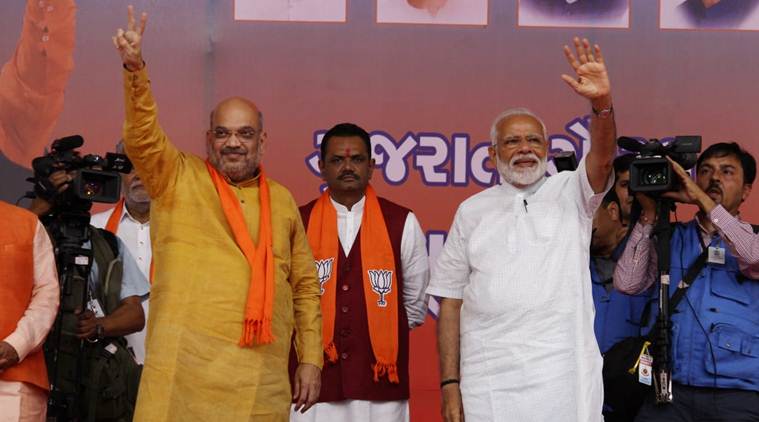
The importance of Amit Shah, not just in party affairs but also in government, was evident even before he was formally sworn in as a minister. Ever since the poll results, Shah has been continuously by Narendra Modi’s side, whether in Delhi, Varanasi or Ahmedabad. Before the swearing-in, the Prime Minister and Shah spent marathon sessions confabulating over the names for the Cabinet. Shah wanted a Cabinet post to demonstrate his administrative capabilities. He wants to be perceived as not just a wizard organisation man, but as Modi’s eventual successor. This is similar to the L K Advani syndrome, where for years Advani was the backroom boy and Atal Bihari Vajpayee the face of the BJP. Finally, Advani decided he wanted to share the glory of the centrestage. Despite being Home Minister, Shah is expected to continue to devote considerable time to party affairs, particularly with Maharashtra and Haryana Assembly elections due shortly.
Financial asset
Nirmala Sitharaman was selected to head the Finance Ministry since, apart from some familiarity with the ministry, Modi wanted a person he considered not close to any business lobby. Earlier, Arun Jaitley, Sitharaman’s mentor, was one of the few who fitted the bill. The ministry controls all the powerful economic regulatory bodies. A scholarly understanding of finance is not essential since, in the Modi regime, senior officials and technocrats, selected and vetted by the PMO, play an important role in key ministries.
Peacock colours
At the 2014 swearing-in, Smriti Irani stood out in terms of sartorial style for her bright red, yellow and black sari emblazoned with huge lotuses. This time the male ministers stole the limelight. Many wore Modi jackets featuring all the colours of the rainbow, including jaundice yellow, shocking pink, sky blue and bottle green. A few like Modi, Shah and Rajnath Singh settled for more formal greys and browns. Women ministers Nirmala Sitharaman and Harsimrat Kaur Badal wore pastle pinks. Smriti was dressed in a smart and subdued orange ikkat silk.
Mamata’s retreat
For three days after the election results, Mamata Banerjee remained shut at her Kalighat residence. She spent her time reading, playing music on a keyboard and introspecting. A string of Trinamool members close to her, including Indranil Sen, Dola Sen and Indrani Haldar, could not get an audience. Her nephew Abhishek Banerjee was one of the few permitted entry, but after 10 pm. By Monday though, Banerjee was back at office, intent to fight fiercely for her turf. Her strategy is focusing on Bengali pride and painting the BJP as outsiders. Party members are too timid to tell her that her habit of getting out of her car and screaming at bystanders shouting Jai Shri Ram lost her votes, since the videos went viral.
Double trouble
The poll defeats have exacerbated trouble in both H D Deve Gowda and Lalu Prasad’s families. Only Gowda’s grandson Prajwal Revanna won, since he was gifted his grandfather’s pocketborough of Hassan. Gowda himself and his other grandson, Nikhil Kumaraswamy, son of Chief Minister H D Kumaraswamy, lost. A Karnataka periodical claimed that a drunk Nikhil berated his 86-year-old grandfather charging that the family had let him down. The Karnataka Police registered an FIR against the periodical. Prajwal, meanwhile, offered to resign to accommodate his grandfather, but Gowda declined.
In Bihar, many RJD leaders blame the feud between Lalu’s sons Tej Pratap Yadav and Tejashwi Yadav for the party’s disastrous showing. The RJD did not win a single seat. Even Pataliputra where Lalu’s daughter Misa Bharti was the candidate and Saran, Lalu’s old constituency, from where Tej Pratap’s estranged father-in-law Chandrika Rai stood, were lost. Small wonder that Lalu convalescing in a Ranchi hospital refused to eat for two days after the results. Tej Pratap’s post-defeat letter backing his brother for party leadership was too little too late.
Master of game
No one can doubt Amit Shah’s abilities as a master campaign strategist. Shah knew exactly which disgruntled elements from opposing camps to cultivate and which to ignore. For instance, Mukul Roy was propped up since Shah was aware that Roy had intimate knowledge of the Trinamool’s organisation and its money and muscle power. In UP, through intermediaries he encouraged the Samajwadi Party’s key organisation man, Shivpal Yadav, to float a separate party. Shivpal damaged the SP in half a dozen seats. Similarly, the Prakash Ambedkar and Asaduddin Owaisi alliance in Maharashtra lost the Congress-NCP several seats.